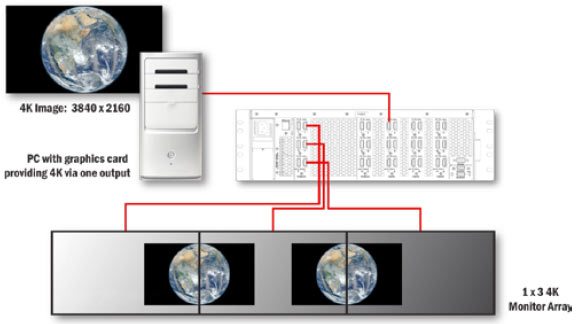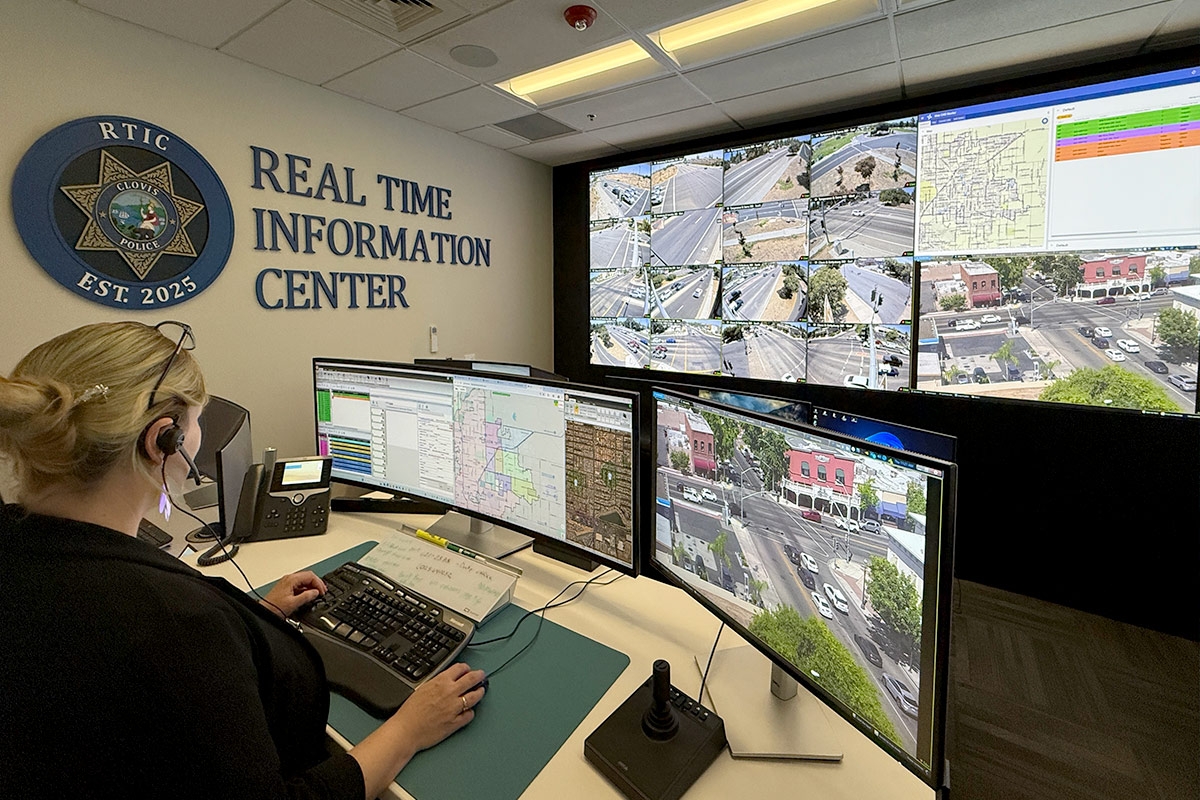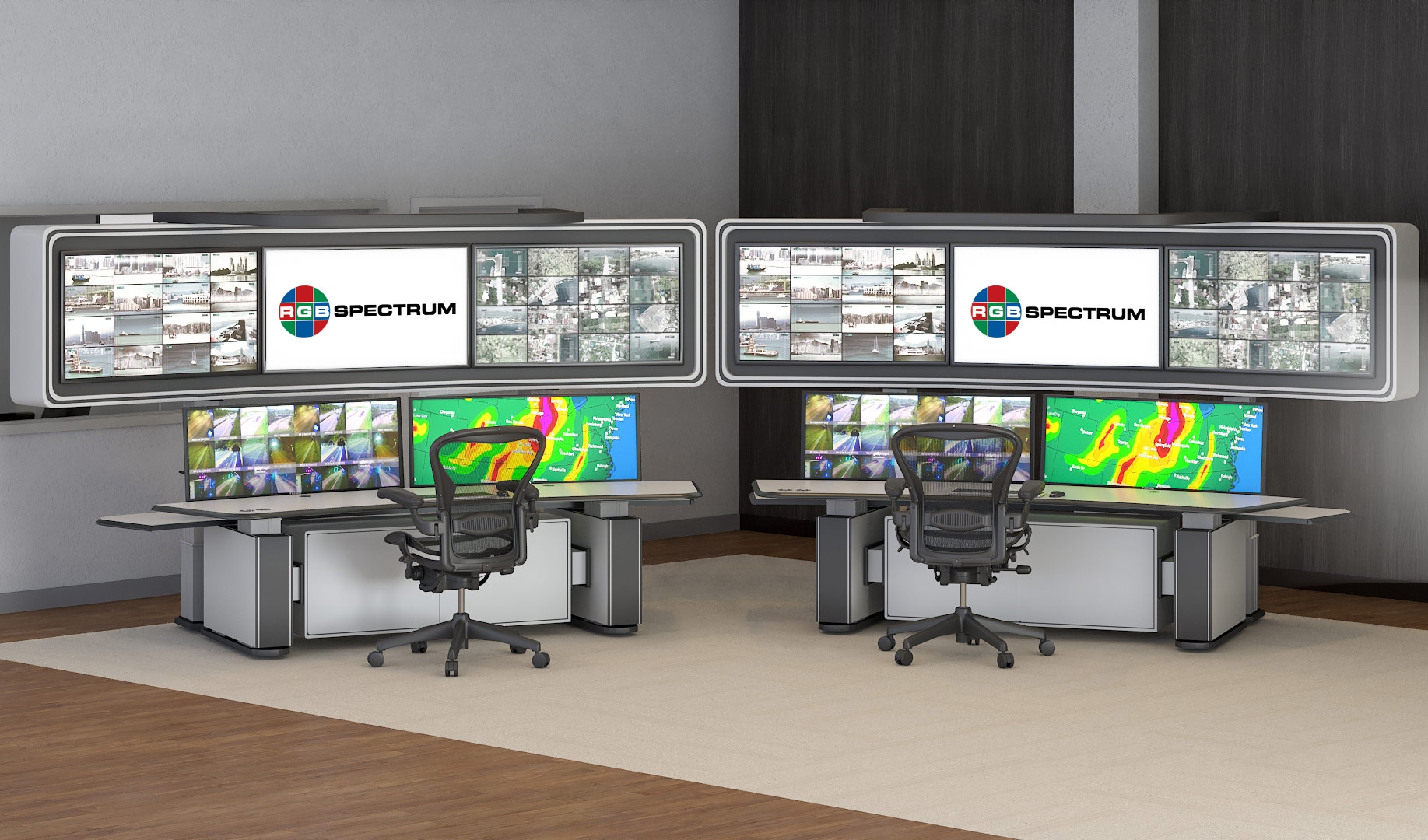4K Technology Primer: Part 3
A New Paradigm—The Desktop Wall
Video wall imagery is typically composed of windows containing graphics or video content provided by source systems such as computers or set-top boxes. Today, most source systems output 1080p video, which would entirely cover one 1080p monitor — if the video is displayed unscaled.
A single 4K workstation monitor packs 8.3 million pixels into a desktop size display, in diagonal sizes ranging from 27” to 32”. How could this type of display technology be used to create a “desktop” video wall?
If a 4K UHD desktop monitor is used in conjunction with an RGB Spectrum MediaWall® V processor or QuadView® UHD multiviewer, one could display four full-resolution (un-scaled) 1080p input windows on-screen — one in each quadrant of the monitor. If a workstation is configured with three adjacent 4K UHD displays, for example, an operator could monitor 12 full-resolution video feeds with superb clarity. This is a remarkable amount of data, displayed without any loss of resolution — and all possible with the MediaWall V processor.
A 4K desktop wall would be ideal for customers who need to track real-time video/graphic information from a multitude of sources in high resolution, particularly if a VMS (Video Management Software) program is employed. These systems multiplex large numbers of cameras onto a single screen and are utilized in applications such as traffic management centers, casinos, and municipal emergency operations centers. The pixel density provided by a 4K desktop wall results in unsurpassed image clarity, no matter how closely an operator views the monitors.
In this manner, the MediaWall V processor enables the “Desktop” wall as a viable concept. For added functionality, the MediaWall V processor is compatible with RGB Spectrum’s Enterprise MCMS, a powerful control room system that allows operators to share keyboard and mouse control over multiple system resources. The result is a customizable workstation-based control room solution with incredibly powerful UHD video display capabilities.
A Pioneer in 4K Processing
RGB Spectrum has been at the forefront of 4K product development since the launch of its SuperView 4K Multiviewer in early 2013. With the introduction of the next-generation MediaWall V and Galileo Display Processors and the QuadView® UHD multiviewer and Zio networked AV products, the process of connecting, manipulating, and processing 4K signals is greatly simplified.
These products are designed to input and output 4K signals via the HDMI® 1.4 format. Compared to HDMI® 1.3, which (in general) processes 1080p signals, HDMI® 1.4 increases the resolution to 4096x2160 at 24Hz (for digital cinema) and 3840x2160 at 24 or 30Hz. In addition to HDMI®, the Galileo, and MediaWall V display processors also output signals in the DisplayPort format, allowing it to provide output signals up to 4096x2160 at 60Hz.
To the layman, this means a single-wire 4K connection to and from the display processor or multiviewer — obviating the need to split the 4K signal into four HD quadrants.
As a result, the connection from a 4K source to the display processor is via a single HDMI® cable — provided that the PC with the 4K source has a graphics card capable of delivering 4K via one output port. Similarly, the connection from the display processor or multiviewer to one (or more) 4K monitors is also via a single cable.

MediaWall V 4K input and output connection
Beyond the display of 4K imagery, a big advantage of incorporating 4K-enabled systems into control rooms or audiovisual environments is having 8 megapixels of resolution. This allows, for example, multiple HD images to be viewed in their original, native resolution. RGB Spectrum’s MediaWall V and Galileo display processors, QuadView® UHD multiviewer, and Zio Networked AV products support single-wire 4K inputs and outputs, as well as lower resolution input/output signals.
RGB Spectrum is a leading designer and manufacturer of mission-critical, real-time audio-visual solutions for a civilian, government, and military client base. The company offers integrated hardware, software, and control systems to satisfy the most demanding requirements. Since 1987, RGB Spectrum has been dedicated to helping its customers achieve Better Decisions. Faster.™


